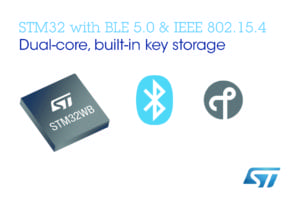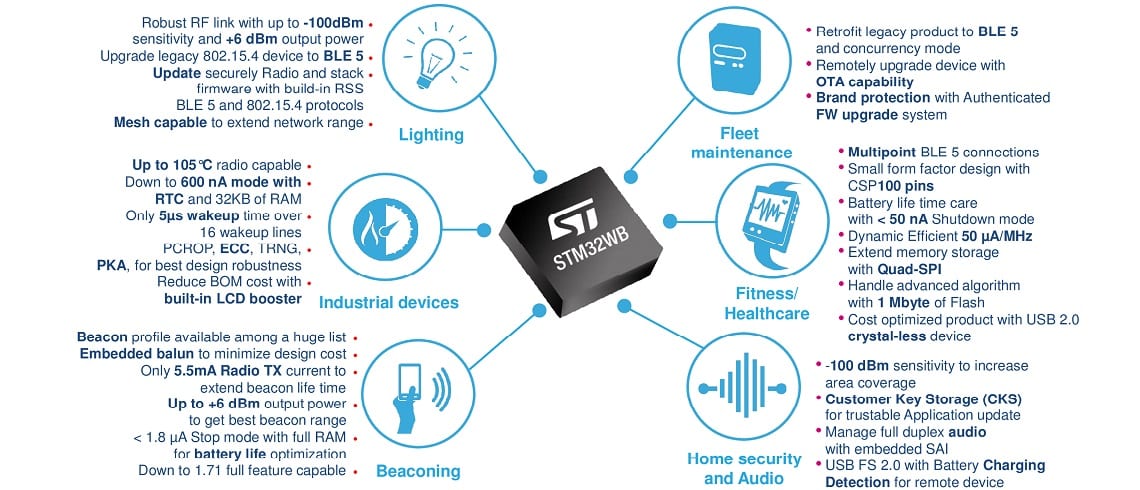With 799 parts in the STM32 family, you might expect the MCUs that push the family across the 800-device threshold to be seminal devices — and they are.
Today, ST announced the STM32WB, its first dual Arm® Cortex®-M-core MCUs in a new pillar of devices that complement the three existing high-performance, mainstream, and ultra-low power pillars of the STM32 family by emphasizing wireless connectivity. On top of a high-performance Arm Cortex-M4 core dedicated to application processing, these new STM32 MCUs integrate an independent Arm Cortex-M0+ core to drive a 2.4-GHz multi-protocol radio that supports Bluetooth 5.0, Thread, and proprietary IEEE 802.15.4 in a concurrent mode; the M0+ core also handles security and protection. Ultra-efficient, the STM32WB MCUs run with power consumption down to 50 µA/MHz in Active mode and 600 nA in Standby mode with 32 Kbytes of SRAM retention and the RTC running. Integration of the circuits to connect to an antenna balun and generous memory options — 128 or 256 Kbytes of RAM and 256-, 512-KBytes, or 1 MBytes of Flash memory — complete the picture.
With the 2.4 GHz radio controlled by the ULP Cortex-M0+ core, it consumes as little as 3.8mA receiving and 5.5mA in transmit mode at (at 0 dBm), yet is capable of +6dBm output power. The radio controller contains certified protocol stacks, including ST’s OpenThread stack and Bluetooth 5 stack with Mesh 1.0 support. The radio’s generic HCI and Media Access Control (MAC) layer gives developers the flexibility to use their own choice of Bluetooth Low Energy (BLE) stack or other IEEE 802.15.4 proprietary stacks.
In recognizing the increasing importance of security and protection, ST designed the STM32WB to leverage its security expertise by integrating embedded customer-key storage, an elliptic curve encryption engine for Public Key Authorization (PKA), and hardware support for AES 256-bit cryptography. In addition, vendors can also future-proof products in the field, leveraging Secure Firmware Update (SFU) and support for Root Secure Service (RSS) to authenticate Over the Air (OTA) updates.
The STM32WB also leverages our deep vault of low-power-peripheral IP, including timers, ultra-low-power comparators, 12/16-bit SAR ADC, a capacitive touch controller, LCD controller, and industry-standard connectivity including crystal-less USB 2.0 FS, I2C, SPI, SAI audio interface, and a Quad-SPI supporting execution in place.
And, of course, the STM32WB benefits from the full arsenal of development tools in the STM32 ecosystem — and then some. While developers and makers can take advantage of the existing tools, including STM32CubeMX pinout/clock configurator and code generator, STM32CubeWB MCU Package, peripheral drivers, middleware, and code examples, ST is adding a dedicated STM32 Nucleo board to accelerate time to market. More important, to assist STM32WB-specific development, we’ve added a dedicated connectivity tool, STM32CubeMonitor-RF, which simplifies radio testing.
